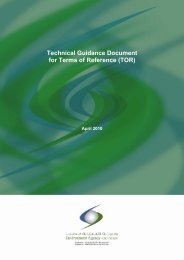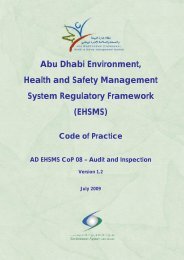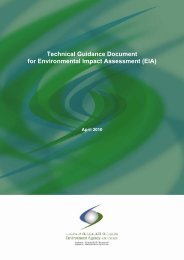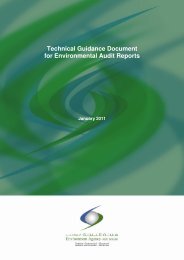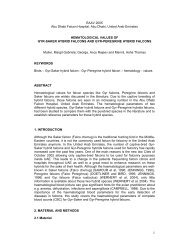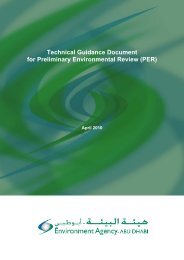Technical Guidance Document for Environmental Action Plan (EAP)
Technical Guidance Document for Environmental Action Plan (EAP)
Technical Guidance Document for Environmental Action Plan (EAP)
You also want an ePaper? Increase the reach of your titles
YUMPU automatically turns print PDFs into web optimized ePapers that Google loves.
<strong>Technical</strong> <strong>Guidance</strong> <strong>Document</strong> <strong>for</strong> <strong>Environmental</strong> <strong>Action</strong> <strong>Plan</strong><br />
3. Root Cause Analysis<br />
After the problem finding has been identified and reported, it should be evaluated to determine the<br />
contributing factors to the issue to develop the corrective actions that will effectively resolve the<br />
finding and prevent recurrence.<br />
For each identified problem finding, a discussion of the contributing factors that resulted in the<br />
violation should be provided. The inclusion of root cause(s) will enable the facility not only to resolve<br />
the issue immediately, but also to prevent recurrence. Sufficient detail also should be provided to<br />
explain why the root cause that was chosen is appropriate.<br />
Examples of root causes <strong>for</strong> problem findings can include, but are not limited to, the following:<br />
• EHS management is not aware of applicable regulations<br />
• EHS management misinterpreted applicable regulations<br />
• Inadequate oversight of contractor operations<br />
• EHS responsibilities are not clearly defined<br />
• Internal plans <strong>for</strong> EHS compliance (e.g., Construction <strong>Environmental</strong> Management <strong>Plan</strong> or<br />
Operation <strong>Environmental</strong> Management <strong>Plan</strong>) are not developed or are inadequate<br />
• Training is not per<strong>for</strong>med or is inadequate<br />
• <strong>Document</strong> control and reporting is inadequate<br />
• <strong>Environmental</strong> monitoring is not per<strong>for</strong>med or is inadequate<br />
• Equipment malfunction<br />
• Emergency situation.<br />
Each problem should be evaluated as follows:<br />
• Begin as soon as possible after identifying the problem to obtain and preserve evidence and<br />
data that can be used to describe the problem and determining the contributing factors. Any<br />
delays could result in changes, deterioration, or loss of in<strong>for</strong>mation that may have been a<br />
contributing or direct causal factor involved in the problem.<br />
• Ensure that evaluating individuals or teams possess technical expertise in the area being<br />
evaluated and that they are qualified to conduct analytical techniques <strong>for</strong> determining<br />
contributing factors involved in the problem and <strong>for</strong> conducting a root cause analysis.<br />
• Review all in<strong>for</strong>mation to determine the facts of what actually occurred. These facts should be<br />
continually validated and analysed, individually and together, <strong>for</strong> relevance and accuracy in<br />
determining what and the way in which it happened. Any missing in<strong>for</strong>mation or<br />
inconsistencies identified during analysis of the finding should be reviewed and followed up.<br />
• Ensure that in<strong>for</strong>mation and physical evidence collected concerning the identified problem<br />
finding (e.g., recorded data on equipment and instruments, inspection and test results, the<br />
actual defective item or photographs) of it is verified, documented, and preserved.<br />
• Solicit input from both the assessor who identified the problem finding and the organisation<br />
or the individual responsible <strong>for</strong> the activity where the problem finding was identified.<br />
• Determine the significance and the potential or actual impact of the problem finding to the<br />
following:<br />
– EHS and security of the site and public<br />
– Compliance with laws and regulatory requirements<br />
– Resource costs (e.g., funding, personnel, time)<br />
– Consequences if the finding is not resolved or if it recurs<br />
– Extent the finding has on other activities, facilities, or equipment not directly involved in<br />
the finding.<br />
7





